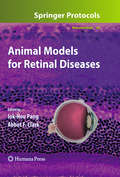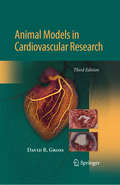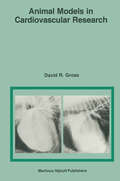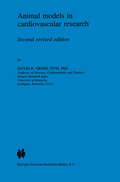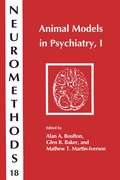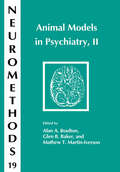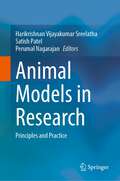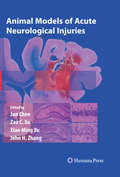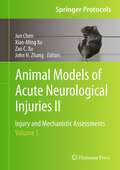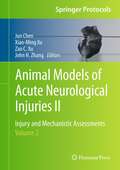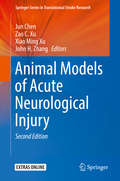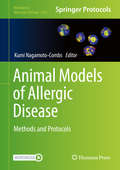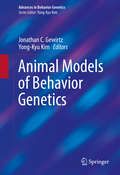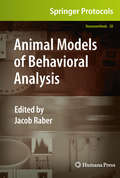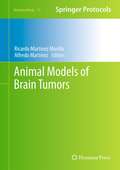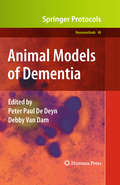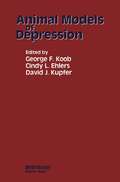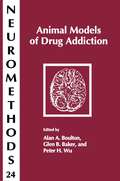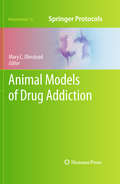- Table View
- List View
Animal Models for Retinal Diseases (Neuromethods #46)
by Iok-Hou Pang and Abbot F. ClarkAffecting over a hundred million individuals worldwide, retinal diseases are among the leading causes of irreversible visual impairment and blindness, and appropriate study models, especially animal models, are essential to furthering our understanding of the etiology, pathology, and progression of these endemic diseases. In Animal Models for Retinal Diseases, recognized experts in the field highlight valuable techniques as well as animal models for the prominent retinal diseases in order to aid in the evaluation, development, and improvement of therapeutic strategies. Beginning with an overview of the morphology of the retina, visual behavior, and genetics and genomics approaches for retinal research, the book continues by covering animal models for the research of specific human retinal diseases, e.g., retinal degeneration, age-related macular degeneration, retinopathy of prematurity, diabetic retinopathy, glaucoma, retinal ischemia, and retinal inflammation. As a volume in the successful Neuromethods series, the chapters provide authoritative reviews of the most commonly used approaches in the field. Vital and easy to use, Animal Models for Retinal Diseases serves to support the important future research of ocular investigators, ophthalmologists, and neuroscientists currently delving into this fascinating field of study.
Animal Models for the Development of Cancer Immunotherapy
by Seng-Lai TanAnimal Models for the Development of Cancer Immunotherapy Provides readers with a clear understanding of the value and challenges of using common and emerging preclinical models in cancer immunotherapy research and development. Animal models are essential tools for studying a range of issues in preclinical and clinical research on therapies targeting cancerous tumors. As clinical trials of advances in cancer immunotherapy are predicted to outpace preclinical research in the near future, there remains an urgent need to develop better animal models for preclinical evaluation of novel modulators. Animal Models for the Development of Cancer Immunotherapy provides a detailed overview of different preclinical model systems for development of novel cancer immunotherapies while highlighting how key aspects of individual models translate into clinical findings. Covering the introduction, development, and therapeutic applications of animal models for cancer immunotherapy, this comprehensive volume helps pharmacologists identify suitable animal models, design pharmacological or translational studies, and advance their mechanistic understanding of therapeutic agents, and increase the possibility of success for novel immunotherapies in clinical settings. Chapters written by prominent leaders in the field address specific models that evaluate immuno-oncology drugs are supported by in-depth case studies and extensive references throughout. Emphasizes the importance of modeling tumor metastasis in preclinical models for efficient translation of findings into the clinic Explores recently discovered mechanisms of resistance and their preclinical modeling Highlights the unique characteristics and features of autologous and allogeneic approaches for humanization of mouse models Reviews development of bone marrow-liver-thymus (BLT) immune humanized mice and emerging alternative models such as genetically engineered mouse models (GEMM) Discusses alternative animal models for cancer research such as severe combined immunodeficiency (SCID) pigs Animal Models for the Development of Cancer Immunotherapy is an essential resource for scientists and researchers in the pharmaceutical and biotechnology industries, medicinal chemists and biochemists, cell and molecular biologists, pharmacologists, immunologists, and clinicians.
Animal Models for the Development of Cancer Immunotherapy
by Seng-Lai TanAnimal Models for the Development of Cancer Immunotherapy Provides readers with a clear understanding of the value and challenges of using common and emerging preclinical models in cancer immunotherapy research and development. Animal models are essential tools for studying a range of issues in preclinical and clinical research on therapies targeting cancerous tumors. As clinical trials of advances in cancer immunotherapy are predicted to outpace preclinical research in the near future, there remains an urgent need to develop better animal models for preclinical evaluation of novel modulators. Animal Models for the Development of Cancer Immunotherapy provides a detailed overview of different preclinical model systems for development of novel cancer immunotherapies while highlighting how key aspects of individual models translate into clinical findings. Covering the introduction, development, and therapeutic applications of animal models for cancer immunotherapy, this comprehensive volume helps pharmacologists identify suitable animal models, design pharmacological or translational studies, and advance their mechanistic understanding of therapeutic agents, and increase the possibility of success for novel immunotherapies in clinical settings. Chapters written by prominent leaders in the field address specific models that evaluate immuno-oncology drugs are supported by in-depth case studies and extensive references throughout. Emphasizes the importance of modeling tumor metastasis in preclinical models for efficient translation of findings into the clinic Explores recently discovered mechanisms of resistance and their preclinical modeling Highlights the unique characteristics and features of autologous and allogeneic approaches for humanization of mouse models Reviews development of bone marrow-liver-thymus (BLT) immune humanized mice and emerging alternative models such as genetically engineered mouse models (GEMM) Discusses alternative animal models for cancer research such as severe combined immunodeficiency (SCID) pigs Animal Models for the Development of Cancer Immunotherapy is an essential resource for scientists and researchers in the pharmaceutical and biotechnology industries, medicinal chemists and biochemists, cell and molecular biologists, pharmacologists, immunologists, and clinicians.
Animal Models in Cardiovascular Research (Developments In Cardiovascular Medicine Ser. #Vol. 153)
by David GrossInterest in the humane and scientifically justifiable use of research animals has intensified since the publication of the 2nd edition of Animal Models in Cardiovascular Research. This completely revised and updated edition will provide information essential to any researcher interested in using animal models for cardiovascular research, or any research which requires normal cardiovascular function. The format and presentation will be changed to make the text more easy to read and use: (1) This edition is in outline format, for ease and utility. (2) The opening chapter includes more information on the cardiovascular effects of post-operative analgesia and will address the recognition of pain behavior in species commonly used in research settings, particularly rats and mice. (3) New edition includes reference material more useful to researchers using transgenic and naturally occurring animal models to dissect these mechanisms.
Animal models in cardiovascular research (Developments in Cardiovascular Medicine #153)
by D.R. GrossInterest in the humane and scientifically justifiable use of research animals has intensified since the publication of the first edition of this textbook. This completely revised and updated text provides information essential to any researcher interested in using animal models for cardiovascular research, or any research which requires normal cardiovascular function. The format and presentation have been changed to make the text more easy to read and use. An introductory chapter offers general principles of animal selection, pre and post-operative care, preanesthesia, chemical restraint, analgesia, and the recognition of pain. The number of references cited has been almost doubled over the previous text and the chapter tabulating normal cardiovascular parameters from intact, awake animals, of those species commonly used in research, has been greatly expanded. Other chapters providing comprehensive data on the cardiovascular effects of opioids, tranquilizers, anesthetic agents and other drugs commonly used in cardiovascular research have been expanded with special emphasis on species variability to drug effects. The chapters on both naturally occurring and iatrogenic models of cardiovascular disease have also been expanded and updated.
Animal Models in Diabetes Research (Methods in Molecular Biology #933)
by Hans-Georg Joost, Hadi Al-Hasani and Annette SchürmannIn recent years, human studies have made enormous contributions towards an understanding of the genetic basis of diabetes mellitus; however, most of the experimentation needed for the invention and testing of novel therapeutic approaches cannot be performed in humans. Thus, there is no alternative to appropriate animal models. In Animal Models in Diabetes Research, expert researchers explore the current status of the most important models and procedures in order to provide a timely resource in experimental diabetology. The first half of the volume serves as a comprehensive overview on our current knowledge of the pathogenesis and pathophysiology of diabetes in animal models through a series of reviews in model strains. The book then continues with vital, established protocols that are employed in the characterization and study of animal models of diabetes. As a volume in the highly successful Methods in Molecular Biology™ series, this work contains the type of detailed description and key implementation advice necessary to achieve successful results. Authoritative and cutting-edge, Animal Models in Diabetes Research delivers essential content that will be an important resource to advance diabetes research in the years to come.
Animal Models in Parasitology (pdf): A Symposium held at the Royal Zoological Society, Regents Park, London, in March 1981
by Dawn OwenAnimal Models in Psychiatry, I (Neuromethods #18)
by Alan A. Boulton, Glen B. Baker and Mathew T. Martin-IversonThe two Animal Models in Psychiatry volumes are loosely organized by subject. The first volume contains a number of chapters concerned with schizophrenia, psyc- ses, neuroleptic-induced tardive dyskinesias, and other d- orders that may involve dopamine, such as attention deficit disorder and mania. The second volume deals with affective and anxiety disorders, but also includes chapters on subjects not easily classified as either psychotic, or affective, or an- ety-related, such as aggression, mental retardation, and memory disorders. Four chapters on animal models of schizophrenia or psychoses are included in the present v- ume because of the importance of these disorders in p- chiatry. Likewise, three chapters in the subsequent volume deal with depression. The first of the two volumes begins with an introd- tion by Paul Willner reviewing the criteria for assessing the validity of animal models in psychiatry. He has written - tensively on this subject, and his thorough description of the issues of various forms of validity provides a framework in which to evaluate the subsequent chapters. As will be seen, the remaining chapters in both volumes will refer frequently to these issues. The second chapter, by Melvin Lyon, describes a large number of different procedures that have been p- posed as potential animal models of schizophrenia. This is a departure from the usual format, consisting of detailed - scriptions of specific models.
Animal Models in Psychiatry, II (Neuromethods #19)
by Alan A. Boulton, Glen B. Baker and Mathew T. Martin-IversonThe two Animal Models in Psychiatry volumes are loosely organized by subject. The first volume contains a number of chapters concerned with schizophrenia, psyc- ses, neuroleptic-induced tardive dyskinesias, and other d- orders that may involve dopamine, such as attention deficit disorder and mania. Also included is a chapter describing a behavioral model for activity-induced anorexia. The second volume deals with affective and anxiety disorders, but also includes chapters on subjects not easily classified as either psychotic, affective, or anxiety-related, such as aggression, mental retardation, and memory disorders. Four chapters on animal models of schizophrenia or psychoses are included in Volume 18 because of the importance of these disorders in psychiatry. Likewise, three chapters in the present v- ume deal with affective disorders, with a fourth chapter on circadian rhythms that also contributes to methods for a- mal models in affective disorders. Following the first four chapters are two chapters dealing with models of anxiety and panic, two chapters on aggression, one on mental retardation, and a final chapter covering memory disorders. Many of the behaviorally-based models of affective disorders involve inducing stress in a- mals, usually on a chronic basis. The first chapter by Anisman, Zalcman, Shanks, and Zacharko describes some of the neurochemical effects that are associated with the chronic application of sensors.
Animal Models in Research: Principles and Practice
by Harikrishnan Vijayakumar Sreelatha Satish Patel Perumal NagarajanThis book describes the development of animal models widely used in biomedical research using step-wise instructions and photographs. Showcasing a wide range of species from zebra fishes, birds, rodents, rabbits, dogs, and pigs, the book includes detailed methodology on how to work with these species and to develop various models. The animal models in neurology including stroke, Alzheimer’s disease, Parkinson’s disease, and Schizophrenia; Animal models in cancer research, sleep disorders, and cardiovascular diseases are described to meet the understanding of researchers who plan to replicate these models in their laboratories. In depth detailing on the development of targeted gene knockouts and transgenics, implantation models that are used in toxicology studies, and pharmacokinetic studies in pigs and dogs are a highlight. Further, the book describes pharmacologic, chemically induced, surgically induced, microbiologically induced, infectious models, models for neurobehavioral studies, oncology research, and pain research. The book has dedicated sections on anesthesia and analgesia and teaches procedures like venous cut-downs and cannulations in pigs and dogs, and endotracheal intubation, mechanical ventilation and thoracotomy in rodents and will serve as a self-training tool. Concepts in the field of animal model development are explained using examples. Sample size selection, study design, and statistical evaluation of experiments involving laboratory animals are explained to enable young researchers to practically understand the nuances. This book will be a valuable tool for academicians, students, scientists, and veterinarians and will benefit equally who are new to the field and who are already working with laboratory animals.
Animal Models in Toxicology
by Shayne C. GadAnimal Models in Toxicology is a single-source reference for the use of animal models in toxicology. Chapters cover nine species used in toxicology and experimental biology. With contributions from experts in toxicology, toxicological pathology, and species-specific metabolism, each of these chapters provides an excellent introductory "course" alon
Animal Models in Toxicology
by Shayne Cox GadAnimal Models in Toxicology is a single-source reference for the use of animal models in toxicology. Chapters cover nine species used in toxicology and experimental biology. With contributions from experts in toxicology, toxicological pathology, and species-specific metabolism, each of these chapters provides an excellent introductory "course" alon
Animal Models of Acute Neurological Injuries (Springer Protocols Handbooks)
by Jun Chen Xiao-Ming Xu Zao C. XuDespite numerous recent studies and exciting discoveries in the field, only limited treatment is available today for the victims of acute neurological injuries. Animal Models of Acute Neurological Injuries provides a standardized methodology manual designed to eliminate the inconsistent preparations and variability that currently jeopardizes advances in the field. Contributed by top experts and many original developers of the models, each chapter contains a step-by-step, proven procedure and visual aids covering the most commonly used animal models of neurological injury in order to highlight the practical applications of animal models rather than the theoretical issues. This intensive volume presents its readily reproducible protocols with great clarity and consistency to best aid neuroscientists and neurobiologists in laboratory testing and experimentation. Comprehensive and cutting-edge, Animal Models of Acute Neurological Injuries is an ideal guide for scientists and researchers who wish to pursue this vital course of study with the proficiency and precision that the field requires.
Animal Models of Acute Neurological Injuries II: Injury and Mechanistic Assessments, Volume 1 (Springer Protocols Handbooks)
by Jun Chen, Xiao-Ming Xu, Zao C. Xu and John H. ZhangThe successful previous volume on this topic provided a detailed benchwork manual for the most commonly used animal models of acute neurological injuries including cerebral ischemia, hemorrhage, vasospasm, and traumatic brain and spinal cord injuries. Animal Models of Acute Neurological Injuries II: Injury and Mechanistic Assessments aims to collect chapters on assessing these disorders from cells and molecules to behavior and imaging. These comprehensive assessments are the key for understanding disease mechanisms as well as developing novel therapeutic strategies to ameliorate or even prevent damages to the nervous system. Volume 1 examines general assessments in morphology, physiology, biochemistry and molecular biology, neurobehavior, and neuroimaging, as well as extensive sections on subarachnoid hemorrhage, cerebral vasospasm, and intracerebral hemorrhage. Designed to provide both expert guidance and step-by-step procedures, chapters serve to increase understanding in what, why, when, where, and how a particular assessment is used. Accessible and essential, Animal Models of Acute Neurological Injuries II: Injury and Mechanistic Assessments will be useful for trainees or beginners in their assessments of acute neurological injuries, for experienced scientists from other research fields who are interested in either switching fields or exploring new opportunities, and for established scientists within the field who wish to employ new assessments.
Animal Models of Acute Neurological Injuries II: Injury and Mechanistic Assessments, Volume 2 (Springer Protocols Handbooks)
by Jun Chen, Xiao-Ming Xu, Zao C. Xu and John H. ZhangThe successful previous volume on this topic provided a detailed benchwork manual for the most commonly used animal models of acute neurological injuries including cerebral ischemia, hemorrhage, vasospasm, and traumatic brain and spinal cord injuries. Animal Models of Acute Neurological Injuries II: Injury and Mechanistic Assessments aims to collect chapters on assessing these disorders from cells and molecules to behavior and imaging. These comprehensive assessments are the key for understanding disease mechanisms as well as developing novel therapeutic strategies to ameliorate or even prevent damages to the nervous system. Volume 2 examines global cerebral ischemia, focal cerebral ischemia, and neonatal hypoxia-ischemia, as well as intensive sections covering traumatic brain injury and spinal cord injury. Designed to provide both expert guidance and step-by-step procedures, chapters serve to increase understanding in what, why, when, where, and how a particular assessment is used. Accessible and essential, Animal Models of Acute Neurological Injuries II: Injury and Mechanistic Assessments will be useful for trainees or beginners in their assessments of acute neurological injuries, for experienced scientists from other research fields who are interested in either switching fields or exploring new opportunities, and for established scientists within the field who wish to employ new assessments.
Animal Models of Acute Neurological Injury: Injury And Mechanistic Assessments, Volume 1 (Springer Series in Translational Stroke Research)
by Jun Chen Zao C. Xu Xiao Ming Xu John H. ZhangDespite numerous recent studies and exciting discoveries in the field, only limited treatments are available today for the victims of acute brain and spinal cord injuries. Animal Models of Acute Neurological Injuries, Second Edition, provides a standardized methodology manual designed to eliminate the inconsistent preparations and variability that often inhibit advances in this specialized research field. In the 10 years since publication of the first edition of this book, some animal models have become obsolete, some have stood the test of time, and newer models have emerged to enhance our knowledge of acute neurological injuries. The second edition continues to offer the research community tested approaches for this area of investigation.As with the first edition, top experts have developed and contributed these animal models. The book’s focus remains hands-on, practical applications of the models, rather than a theoretical approach. Each chapter contains a proven procedure enhanced by clear figures, illustrations, or videos. This new edition presents its readily reproducible protocols with clarity and consistency to best aid neuroscientists and neurobiologists. As with the first edition, the second edition is comprehensive and cutting-edge. Animal Models of Acute Neurological Injuries, Second Edition, is an ideal guide for research professionals, at all stages of their careers, who wish to pursue this vital course of study with the proficiency and precision required by the field.
Animal Models of Allergic Disease: Methods and Protocols (Methods in Molecular Biology #2223)
by Kumi Nagamoto-CombsThis volume provides protocols for mouse models of allergic diseases and guidelines for choosing a particular strains, allergen, adjuvant, and route of sensitization. Chapters detail types of allergic disease, methods that are frequently employed to analyze pathophysiology of allergic diseases, manipulation of intestinal microbiota, and desensitization of immure responses in animal models. Written in the highly successful Methods in Molecular Biology series format, chapters include introductions to their respective topics, lists of the necessary materials and reagents, step-by-step, readily reproducible laboratory protocols, and tips on troubleshooting and avoiding known pitfalls. Authoritative and cutting-edge, Animal Models of Allergic Disease: Methods and Protocols aims to offer a comprehensive collection of protocols and experience-derived instructions to further allergic disease research.
Animal Models of Behavior Genetics (Advances in Behavior Genetics)
by Jonathan C. Gewirtz Yong-Kyu KimThis stimulating analysis reviews the broad potential of animal models to foster a deeper understanding of human pathology, strengthen connections between genetic and behavioral studies, and develop more effective treatments for mental disorders. Widely-studied and lesser-used species are examined in models that capture features along the continuum of normative and pathological behavior. The models highlight genetic causes of core features, or endophenotypes, of developmental, internalizing, and externalizing disorders, as well as dementia. Expert contributors address questions ranging from how suitable species are chosen for study to the costs and benefits of using inbred versus outbred strains, and the effects of housing environment on subject animals. Larger issues addressed include how to evaluate the applicability of animal behavioral models to the human condition and how these models can harness emerging molecular technologies to further our understanding of the genetic basis of mental illness.Included in the coverage:Mating and fighting in Drosophila.Attachment and social bonding.Impulsivity in rodents and humans.Animal models of cognitive decline.Animal models of social cognition.Future directions for animal models in behavioral genetics.A detailed map of where this evolving field is headed, Animal Models of Behavior Genetics shows geneticists, molecular biologists, and cognitive neuroscientists paths beyond established concepts toward a more knowledgeable and collaborative future.
Animal Models of Behavioral Analysis (Neuromethods #50)
by Jacob RaberDespite the difficulty in comparing clinic-based human tests with animal model testing, there is still great value in pursuing translational approaches, as tests and treatment strategies might be developed to improve brain function in humans suffering from neurological conditions and knowledge obtained from human behavioral studies can be used to further improve the animal models of behavioral analysis. In Animal Models of Behavioral Analysis, expert neuroscientists focus on approaches to translate and compare behavioral tests used in animals with those used in humans not only to increase our understanding of brain function across species but also to provide objective performance measures and bridge the gap between behavioral alterations in humans with cognitive disorders and the correlating animal models of these conditions. Written in the Neuromethods series format, the chapters provide authoritative reviews of many commonly used approaches in the field today. Provocative and cutting-edge, Animal Models of Behavioral Analysis seeks to aid researchers in further developing these vital techniques in an effort to advance studies in both the clinic and the laboratory.
Animal Models of Brain Tumors (Neuromethods #77)
by Ricardo Martínez Murillo and Alfredo MartínezAlthough the available models, whether at the cellular, tissue, or animal level, do not exactly represent the biology of human brain tumors, animal models can offer significant insights into these tumors, providing a better understanding of biological mechanisms underlying tumor generation, growth, angiogenesis, invasion, and metastasis. Animal Models of Brain Tumors brings together developments and discoveries in “in vivo” experimental tumor research that have provided advances in our understanding of the cellular and molecular mechanisms involved in the generation, progression, and clinical outcome of brain neoplasms. Broken into convenient sections, this thorough volume includes topics such as animal model insights into human brain neoplasms, the cellular, molecular, and genetic basis of brain tumors, therapies in the treatment of malignant glioma, as well as imaging technologies in animal tumor models, i.e. measuring brain tumor growth and metabolism. Written for the popular Neuromethods series, chapters include the kind of detailed description and implementation advice that is essential for achieving successful results. Authoritative and cutting-edge, Animal Models of Brain Tumors provides the key methods needed to validate, compare, and contrast the animal model with its proposed human counterpart and further the understanding of our own serious ailments.
Animal Models of Dementia (Neuromethods #48)
by Peter Paul De Deyn and Debby Van DamWith an ever-increasing elderly population and the resultant rising levels of dementia-related disorders, preclinical research based on animal models is pivotal to our knowledge of underlying molecular mechanisms and drug discovery aiming at the development of therapeutic strategies alleviating or preventing the neurological devastation. In Animal Models of Dementia, expert researchers provide contributions that stress the importance of extensively validated animal models in drug discovery and development in order to predict clinical activity. Beginning with general aspects of animal modeling, related ethical issues, and essential methodological considerations, the highly detailed volume then continues with various levels of model validation, including pathological, behavioral, neurochemical, pharmacological, and imaging aspects, followed by sections focused on specific disorders, such as Alzheimer’s disease, Parkinson’s disease, metachromatic leukodystrophy and adrenoleukodystrophy, amyotrophic lateral sclerosis, frontotemporal dementia as well as vascular dementia and more. As a volume in the renowned Neuromethods series, this book offers a detailed, yet accessible, overview of currently available animal models in the field of dementia research, and touches, as well, upon more general areas linked to the development and use of animal models. Comprehensive and efficient, Animal Models of Dementia will significantly aid both experienced animal researchers as well as investigators on the verge of beginning animal model-based dementia research.
Animal Models of Depression
by KOOB EHLERS KUPFERAnimal models represent experimental investigations developed in one species for the purpose of studying phenomena in another species and provide numerous advantages for preclinical research. They allow scientists greater control and isolation of important experimental variables. Animal models are safe, reproducible strategies by which to evaluate and design new pharma cological treatment strategies, while also allowing direct central nervous system intervention to alter the course of the aberrant behavior. Animal models have been developed for a number of mental illnesses; in this particular domain, they hold the promise to shed light on the still obscure etiologies of these illnesses and ultimately to facilitate the development and testing of "cures. " Yet, true models of mental illness are difficult to develop, because mental illness may be a uniquely human phenomenon. It was based on these considerations that the MacArthur Foundation Research Network on the Psychobiology of Depression set out to sponsor a conference to review the status, problems, promises, and relevance of animal models to the clinical conditions of affective disorders. The conference was held in September 1986 and included participants from both within the Network as well as scientists and scholars from various disciplines relevant to the concerns of the conference. After the conference was held, it became clear to the organizers that the material presented could be helpful to a broader field of investigators, since a significant portion of the information has not been presented elsewhere or in the unified context of a monograph.
Animal Models of Drug Addiction (Neuromethods #24)
by Alan A. Boulton, Glen B. Baker and Peter H. Wuto the Animal Models Volumes This volume describes animal models of drug addiction. Because of increasing public concern over the ethical treatment of animals in research, we felt it incumbent upon us to include this general preface in order to indicate why we think further research using animals is necessary. Animals should only be used when suitable alternatives are not available, and humans can only be experimented upon in severely proscribed circumstances. Alternative procedures using cell or tissue culture are inadequate in any models requiring assessments of behavioral change or of complex in vivo p- cesses. However, when the distress, discomfort, or pain to the animals outweighs the anticipated gains for human welfare, the research is not ethical and should not be carried out. It is imperative that each individual researcher examine his/ her own research from a critical moral standpoint before eng- ing in it, and take into consideration the animals’ welfare as well as the anticipated gains. Furthermore, once a decision to p- ceed with research is made, it is the researcher’s responsibility to ensure that the animals’ welfare is of prime concern in terms of appropriate housing, feeding, and maximum reduction of any uncomfortable or distressing effects of the experimental conditions.
Animal Models of Drug Addiction (Neuromethods #53)
by Mary C. OlmsteadOur understanding of addiction and how it is treated has advanced remarkably over the past decades, and much of the progress is related directly to animal research. This is true for both the behavioural aspects of drug use as well as the biological underpinnings of the disorder. In Animal Models of Drug Addiction, experts in the field provide an up-to-date review of complex behavioural paradigms that model different stages of this disorder and explain how each test is used to effectively replicate the progression of drug addiction. This detailed and practical book begins with the most common laboratory measures of addiction in animals, including intracranial self-stimulation (ICSS), drug self-administration, place conditioning, and sensitization. Later chapters describe how these paradigms are used to model the progression of drug addiction, providing insight into the clinical symptomatology of addiction from acquisition of drug use through compulsive drug taking to withdrawal and relapse. Written for the popular Neuromethods series, the contributions offer both methodological detail and a theoretical perspective, appealing to readers familiar with preclinical research on drug addiction as well as those who are newcomers to the field. Cutting-edge and authoritative, Animal Models of Drug Addiction will serve as a basis for future vital research that links the bench to the bedside in the crucial treatment of drug addiction.
